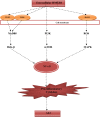High-mobility group box 1 (HMGB1) in COVID-19: extrapolation of dangerous liaisons
- PMID: 35471628
- PMCID: PMC9040700
- DOI: 10.1007/s10787-022-00988-y
High-mobility group box 1 (HMGB1) in COVID-19: extrapolation of dangerous liaisons
Abstract
High-mobility group box 1 (HMGB1), a multifunctional nuclear protein, exists mainly within the nucleus of all mammal eukaryotic cells. It is actively secreted by the necrotic cells as a response to the inflammatory signaling pathway. HMGB1 binds to receptor ligands as RAGE, and TLR and becomes a pro-inflammatory cytokine with a robust capacity to trigger inflammatory response. It is a critical mediator of the pathogenesis of systemic inflammation in numerous inflammatory disorders. Release of HMGB1 is associated with different viral infections and strongly participates in the regulation of viral replication cycles. In COVID-19 era, high HMGB1 serum levels were observed in COVID-19 patients and linked with the disease severity, development of cytokine storm (CS), acute lung injury (ALI) and acute respiratory distress syndrome (ARDS). SARS-CoV-2-induced cytolytic effect may encourage release of HMGB1 due to nuclear damage. Besides, HMGB1 activates release of pro-inflammatory cytokines from immune cells and up-regulation of angiotensin I-converting enzyme 2 (ACE2). Therefore, targeting of the HMGB1 pathway by anti-HMGB1 agents, such as heparin, resveratrol and metformin, may decrease COVID-19 severity. HMGB1 signaling pathway has noteworthy role in the pathogenesis of SARS-CoV-2 infections and linked with development of ALI and ARDS in COVID-19 patients. Different endogenous and exogenous agents may affect release and activation of HMGB1 pathway. Targeting of HMGB1-mediated TLR2/TLR4, RAGE and MAPK signaling, might be a new promising drug candidate against development of ALI and/or ARDS in severely affected COVID-19 patients.
Keywords: Acute respiratory distress syndrome; Anti-HMGB1 agents; COVID-19; High-mobility group box 1; SARS-CoV-2.
© 2022. The Author(s), under exclusive licence to Springer Nature Switzerland AG.
Conflict of interest statement
The authors declare that they have no conflict of interest.
Figures


References
-
- Ackermann M, Verleden SE, Kuehnel M, Haverich A, Welte T, Laenger F, Vanstapel A, Werlein C, Stark H, Tzankov A, Li WW, Li VW, Mentzer SJ, Jonigk D. Pulmonary Vascular Endothelialitis, Thrombosis, and Angiogenesis in Covid-19. N Engl J Med. 2020;383:120–128. doi: 10.1056/NEJMoa2015432. - DOI - PMC - PubMed
-
- Al-Brakati A, Albarakati AJA, Daabo HMA, Baty RS, Salem FEH, Habotta OA, Elmahallawy EK, Abdel-Mohsen DM, Taha H, Akabawy AMA, Kassab RB, Abdel Moneim AE, Amin HK. Neuromodulatory effects of green coffee bean extract against brain damage in male albino rats with experimentally induced diabetes. Metab Brain Dis. 2020;35:1175–1187. doi: 10.1007/s11011-020-00583-6. - DOI - PubMed
-
- Al-Kuraishy HM, Al-Gareeb AI. From SARS-CoV to nCoV-2019: ruction and argument. Arch Clin Infect Dis. 2020;15:e102624. doi: 10.5812/archcid.102624. - DOI
-
- Al-Kuraishy H, Hussien N, Al-Naimi M, Al-Buhadily A, Al-Gareeb A, Lungnier C. Is ivermectin–azithromycin combination the next step for COVID-19? Biomed Biotechnol Res J (BBRJ) 2020;4:101–103.
Publication types
MeSH terms
Substances
LinkOut - more resources
Full Text Sources
Miscellaneous
